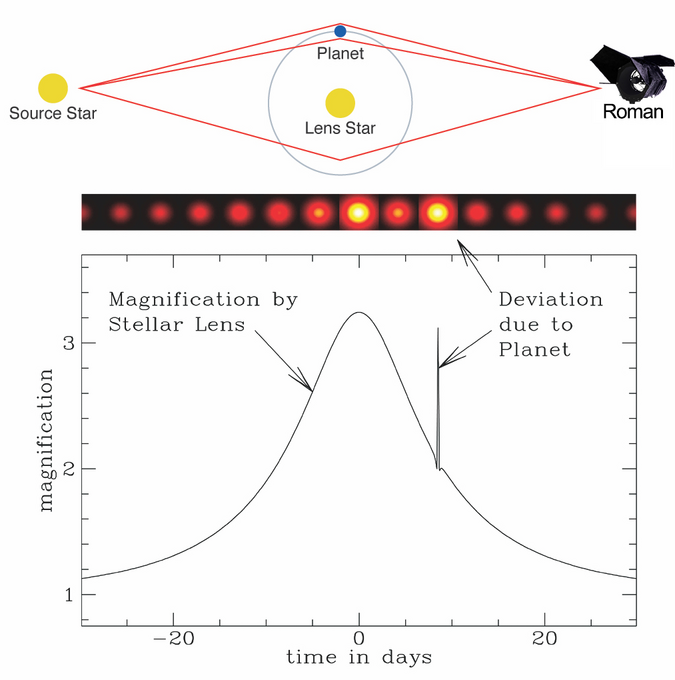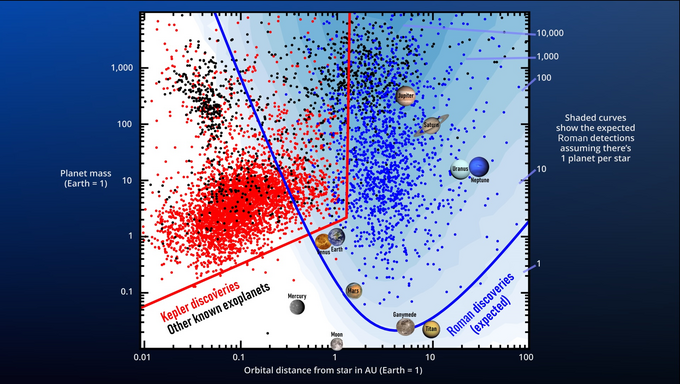
Gravitational microlensing is an observational effect that was predicted in 1936 by Einstein using his General Theory of Relativity. When the angular separation of two stars on the sky becomes sufficiently small, the light rays of the background source star become bent due to the influence of the gravitational field of the foreground star. This acts in the same way as a magnifying glass in amplifying the brightness of the source star, and we hence refer to the foreground star as the lens star. If the lens star harbors a planetary system, then those planets can also act as lenses, producing a short spike in the brightness of the source. Thus their presence can be inferred and we can measure both the planetary mass and the star-planet separation.
Exoplanetary systems can be observed through gravitational microlensing, an effect first described in 1936 by Einstein within the framework of the General Theory of Relativity. The microlensing effect is based upon the deflection of light of a background star (the "source") due to the gravitational field of a foreground star (the "lens") whenever their angular separation, as seen from the observer, becomes small enough (of order of a milliarcsecond). The effect is transient in nature because of the relative proper motion between the source and the lens star, and the observer, with typical event duration lasting from days to few months. During a microlensing event multiple images of the source are formed, with different magnification. However, their angular separation is too small so that the overall observed effect is a variation of the luminosity of the source, with the lens acting as a magnifying glass. If the lens star harbors a planetary system, those planets can also act as lenses producing short deviations (or "anomalies") along the smooth primary microlensing event due to the host star.
The discovery of thousands of exoplanets over the last two decades, with about 100 through the microlensing effect, has confirmed that our solar system is not unique in our galaxy. While the majority of the discovered extra-solar planets are gas giants, similar to Jupiter or Saturn, we have also found many large Earth-like planets called "Super-Earths", which are thought to come in a variety of flavors, depending on whether they are primarily made of iron, silicates, water, or carbon compounds. Understanding the statistics of these planets and the formation processes that produced them are crucial for understanding how our own Solar System formed and how common Earth-like planets may be.

The primary science goal of the Roman Galactic Bulge Time Domain Survey is to complete the statistical census of planetary system in the Galaxy from the outer habitable zone to free floating planets. In particular it aims to include analogs of all of the planets in our Solar System with the mass of Mars or greater. More specifically, the "Design Reference Mission" is designed to cover seven fields, for a total of ~2 square degrees area, in six 62 day season each, with the maximum extension of each season up to 72 days, based upon visibility restrictions. Observations will be carried out with the Wide Field Instrument. Observations of each field will be taken with a 15 minute cadence using the wide filter F146 (centered at 1.46 μm) and every 6 hours with each of two additional filters, a bluer and a redder one. The main purpose of these multifilter ("color") data is the photometric characterization of the source stars for microlensing events, which in turn is key to the determination of the physical parameters of the underlying lensing systems, in particular the planetary systems, whenever they are detected. This space-based microlensing survey will provide the unique opportunity to use microlensing to detect many more planets down to much smaller masses than from the ground. The results from this survey will complement the exoplanet statistics from the Kepler mission, and will provide invaluable information on answering the questions of planet formation, evolution, and their prevalence within the Galaxy.
